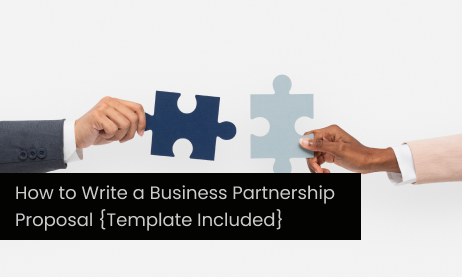A business partnership proposal serves as the first impression of your business philosophy, your understanding of the partnership’s potential, and your vision for mutual growth. It’s not just about presenting what your business can offer, but also about showing that you understand and respect the needs and goals of your potential partner. A well-written proposal can be the key to unlocking fruitful collaborations, opening doors to shared resources, expertise, and markets, thus paving the way for substantial business growth and success.

This article is designed as a comprehensive guide to help you create an impactful business partnership proposal. Ready to write a business partnership proposal? Let’s get started.
Understanding Your Audience
Identifying Potential Partners
The first step in writing a business partnership proposal is to identify the right potential partners. This process involves more than just finding businesses that align with your industry or market. It’s about seeking out companies or individuals who share similar values, goals, and visions. Look for partners who complement your business’s strengths and can help mitigate its weaknesses. This might mean a partner with a strong presence in a market you’re trying to enter or one with access to resources that can help scale your business. Identifying the right partner is crucial as it sets the tone for the entire proposal and the potential partnership.
When identifying potential partners, consider:
– Industry Relevance: Partners in the same or complementary industries are more likely to understand and value your proposal.
– Market Position: Consider how a partner’s market position could benefit your business. For instance, a partnership with a well-established player can offer credibility, while teaming up with an innovative newcomer can provide fresh perspectives.
– Cultural Fit: Aligning with a partner who shares similar business ethics and corporate culture can lead to a smoother collaboration.
– Long-Term Potential: Look for partners who are not just beneficial for a one-time project but could lead to long-term collaboration.

Researching Their Needs and Interests
After identifying potential partners, the next step is to research their specific needs and interests. This research is important as it helps tailor your proposal to address the specific challenges or opportunities your potential partner is facing. By demonstrating that you understand and can provide solutions to their needs, your proposal will be more persuasive and relevant.
To effectively research their needs and interests:
– Review Their Business Model: Understand how they operate, their revenue streams, and their customer base. This helps in aligning your proposal with their business strategy.
– Analyze Their Market Position: Look at their market share, competitors, and industry trends. This insight can help you position your partnership as a solution to specific market challenges they might be facing.
– Understand Their Goals: Whether it’s expansion, diversification, or sustainability, knowing what your potential partner aims to achieve can help you tailor your proposal to align with these goals.
– Use Social Media and Publications: Review their social media platforms, press releases, and industry publications for recent announcements, challenges they’re addressing, or initiatives they’re undertaking. This can provide clues to their current focus and future plans.
– Networking and Direct Communication: Sometimes, the best information comes from direct interaction. Attend industry events, engage in networking opportunities, or even reach out directly to understand their vision and objectives better.
Key Components of a Business Partnership Proposal
Executive Summary
The executive summary is the cornerstone of your business partnership proposal. It should provide a concise, compelling overview of what the proposal entails and why it’s beneficial for both parties. This section is often the first (and sometimes the only) part read by decision-makers, so it needs to be clear, engaging, and persuasive. Highlight the key aspects of the partnership, including the goals, the value proposition, and the main benefits for both parties. The executive summary should be a standalone document that encapsulates the essence of the proposal, compelling the reader to delve deeper into the details.
Business Objectives
This section should outline the specific objectives you hope to achieve through the partnership. Clear, measurable, and realistic goals show a potential partner that you have a well-thought-out plan for the partnership’s success. These objectives could range from expanding into new markets, leveraging each other’s customer base, to combining resources for a new venture. Be specific about what success looks like and how it will be measured. This clarity will help align both parties’ expectations and form the basis for a productive relationship.
Value Proposition
Your value proposition is arguably the most crucial part of the proposal. This is where you articulate the unique benefits that your company brings to the table and why this partnership is advantageous for your potential partner. It should clearly demonstrate how the partnership will create added value for both parties, whether through increased revenue, market expansion, enhanced capabilities, or other strategic advantages. A strong value proposition is tailored to your potential partner’s needs and goals, showing that you have done your homework and understand what they are looking for in a partnership.
Partnership Details
In this section, delve into the specifics of how the partnership will work. Outline the roles and responsibilities of each party, the governance structure of the partnership, and how decisions will be made. Include details about resource allocation, timelines, and project management. If there are any specific projects or initiatives that will kick off the partnership, describe them in detail here. Providing a clear and detailed plan shows that you are serious about the partnership and have considered how to make it successful.
Financial Projections
Financial projections are essential in any business proposal. This section should provide an analysis of the expected financial outcomes of the partnership. Include revenue forecasts, cost analysis, and any investments required from both parties. If possible, use data and analytics to back up your projections. Be realistic and conservative in your estimates. Providing a clear financial picture helps both parties understand the economic implications of the partnership and aids in decision-making.
Legal and Ethical Considerations
In this part of the proposal, address any legal and ethical considerations relevant to the partnership. This might include compliance with industry regulations, intellectual property rights, confidentiality agreements, and any other legal obligations. It’s also important to discuss how ethical considerations will be handled, reflecting a commitment to corporate social responsibility. Addressing these issues upfront builds trust and shows that you are committed to maintaining a professional and ethical business relationship.
Each of these components plays a crucial role in developing a comprehensive and convincing business partnership proposal. They collectively demonstrate your understanding of what it takes to build a successful partnership, reflecting both strategic foresight and attention to detail.
Writing the Business Partnership Proposal
Starting with a Strong Introduction
The introduction of your proposal is where you make your first impression. It sets the tone for the rest of the document and should immediately capture the interest of the reader. A strong introduction goes beyond a simple greeting or a statement of purpose; it should hook the reader by presenting the idea of the partnership, its relevance, and why it matters. This section should echo the excitement and potential you see in the partnership, making it clear why the reader should be interested in what you have to say. Consider starting with a compelling fact, a brief story, or a poignant question that relates directly to the potential partner’s needs or challenges, thus creating a direct connection from the outset.
Clear and Concise Language
The effectiveness of your proposal largely depends on how easily it can be read and understood. Use clear, concise language to ensure your message is conveyed effectively. Avoid jargon and technical terms that might not be familiar to all readers, unless they are industry-standard and necessary. Your aim should be to make the proposal as accessible as possible, so it speaks to decision-makers at all levels. Short, to-the-point sentences are often more powerful than lengthy, complex ones. Remember, clarity and brevity do not mean oversimplifying your ideas; rather, it’s about presenting them in a manner that is easy to grasp and remember.
Personalizing the Proposal
Personalization can significantly increase the impact of your proposal. This involves tailoring the content to directly address the specific needs, interests, and circumstances of the potential partner. Refer to their recent achievements, current projects, or particular challenges they are facing. This shows that you have taken the time to understand them and have thought deeply about how the partnership can be beneficial. Personalization can be achieved through the language you use, the examples you cite, and the specific benefits you highlight. By making the proposal as relevant as possible to the potential partner, you increase the likelihood of engaging their interest and winning their buy-in.
Check out this partnership proposal template from Prospero: https://goprospero.com/proposal/partnership-proposal-template/

Business Partnership Proposal Design and Presentation
Importance of a Professional Look
The design and overall presentation of your business partnership proposal can significantly influence its reception. A professional look not only reflects the seriousness and professionalism of your intent but also helps in making the document more readable and engaging. Attention to detail in the layout, font choice, color scheme, and formatting can make a substantial difference. It’s crucial that the proposal looks organized and aesthetically pleasing.
A well-designed proposal indicates that you have invested time and effort into its preparation, which can leave a lasting impression on the potential partner. This professionalism in presentation extends to ensuring that the document is free of errors, with consistent formatting throughout, further reflecting the quality and reliability of your business.
Using Visuals and Branding
Incorporating visuals and branding elements into your proposal can greatly enhance its impact. Visuals, such as charts, graphs, and images, can help to break up text, making the proposal more engaging and easier to digest. They can also be used effectively to illustrate points, showcase data, or convey complex information in a more accessible way. Branding elements, like your company’s logo and color scheme, help in reinforcing your identity and create a sense of familiarity, especially if the potential partner is already aware of your brand.
However, it’s important to use visuals judiciously. Every image or graph included should serve a clear purpose, such as emphasizing a point or explaining a concept more clearly. The key is to strike a balance – the proposal should be visually appealing and branded, but not so heavily designed that it distracts from the core message.
Business Partnership Proposal Follow-Up Strategies
Post-Submission Follow-Up
Once your proposal has been submitted, the follow-up process plays a crucial role in showing your continued interest and commitment. It’s important to plan and execute a follow-up strategy that is persistent yet respectful. Initially, a simple thank-you message acknowledging their time and consideration in reviewing your proposal can set a positive tone. Afterwards, it’s advisable to wait a reasonable period before following up again, typically a week or two, depending on the nature of the proposal and the urgency of the partnership.
During follow-up communications, it’s important to:
– Reiterate Key Points: Briefly remind them of the most compelling aspects of your proposal.
– Be Open to Discussion: Indicate your willingness to discuss any aspects of the proposal in more details if needed.
-Show Flexibility: Express your readiness to modify aspects of the proposal to better align with their needs or concerns.
Follow-up can be conducted through various channels such as email, phone calls, or even in-person meetings, depending on the level of relationship you have with the potential partner and the formality of the situation.
Conclusion
In conclusion, a business partnership proposal is a strategic document that requires careful thought, detailed planning, and a tailored approach. By following these guidelines, you can create a proposal that lays the foundation for a mutually beneficial business relationship.
Even though this might seem like a lot to handle, remember you don’t have to do it all by yourself. A good place to start is to use a template and a proposal tool like Prospero can really help. Prospero offers different templates and helpful features that can make writing your next proposal a lot easier and better!




